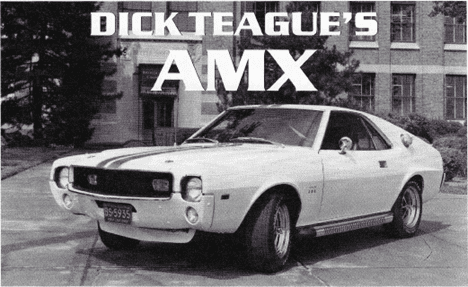The American Motors Corporation (AMC) was primarily known for producing reliable yet forgettable vehicles that aimed to accommodate older drivers. But that all changed in the late 1960s when the manufacturer realized that the company needed a performance facelift.
The company utilized the automotive designing expertise of Dick Teague to design a truly breathtaking pony car — the AMC Javelin. This groundbreaking two-door hardtop made quite a splash in Trans-Am racing, and the second-generation AMX Javelin even became the first pony car used by on-duty police officers.
Here’s what you need to know about Dick Teague’s unforgettable contribution to motor history.
History of AMC Cars Leading Up to the Javelin
 During the 1960s, executives at the American Motors Corporation determined that the company needed to shift its public image. At that time, the company was known for sturdy, reliable vehicles, such as its Rambler, but its vehicles lacked the style and performance to capture younger markets.
During the 1960s, executives at the American Motors Corporation determined that the company needed to shift its public image. At that time, the company was known for sturdy, reliable vehicles, such as its Rambler, but its vehicles lacked the style and performance to capture younger markets.
This was also a time when other American manufacturers enjoyed immense success with the emerging pony car market created by the Ford Mustang.
AMC’s first attempt to change its image came with the 1965 Marlin. The company’s Vice President of Styling, Dick Teague, headed up the design of this two-door fastback automobile. Both critics and the general public didn’t take to AMC’s new vehicle, and the car was by and large considered a failure due to its lack of performance, bizarre style, and Rambler Classic chassis.
After the Marlin flopped, AMC felt even more pressure to release an impressive vehicle that could shift its image. In 1966, AMC went on a publicity tour called Project IV, where they debuted four stunning prototypes designed to target different car markets: the AMX, AMX II, Cavalier, and Vixen. The AMX and AMX II paved the way for Teague’s remarkable 1968 AMX Javelin.
AMC Javelin Specifications
The AMC’s Javelin was not a direct copy of Project IV’s prototypes, but Dick Teague developed the car from the two-seat AMX and the four-seat AMX II. Unlike other pony car developers like Ford and Plymouth, AMC didn’t have the resources to develop multiple body styles for its Javelin, so Dick Teague created a single two-door hardtop style that had a distinct semi-fastback roofline.
AMC constructed the vehicle on their junior Rambler American platform. It sported a 109-inch wheelbase, 189.2-inch length, 71.9-inch width, 51.8-inch height, and a 2,836 lb curb weight. The vehicle shared the same platform as the immensely popular AMC AMX, which was almost an exact replica of Project IV’s AMX.
The car came with 10.2 cubic feet of trunk space, a great deal of legroom and headroom, thin-shell bucket seats, and a carpeted interior. Rather than coming with side vent windows, the car, instead, featured apertures in its doors controlled by flap valves.
Additionally, AMC equipped the car with a distinct honeycomb grille and outboard-mount headlamps, which the company referred to as a “twin-venturi” appearance.
The car’s standard engines were a 232 cu in (3.8 L) straight-6 or a 290 cu in (4.8 L) two-barrel carburetor V8. Those with the 232 cu in could cruise at around 80 mph while the 290 boasted a max speed of 100 mph.
AMC also offered the Javelin “Go Package,” which came with power front disc brakes, heavy-duty suspension, wide full-length body-side stripes, E70x14 red-line tires, and a four-barrel carbureted 343 cu in (5.6 L) AMC V8 engine. This special-package Javelin could go from 0 to 60 in eight seconds and had a top speed of 120 miles per hour.
In the middle of the 1968 model year, AMC began offering a new special package for the Javelin: the 1968 AMX Javelin with the new AMX 390 cu in (6.4 L) that came with either a floor-mounted automatic or a manual four-speed transmission. This breathtaking engine produced 315 hp and enabled the car to go from 0 to 60 in around seven seconds.
AMC Javelin vs. Mustang
In addition to dazzling the public with their new pony car, AMC also experienced great success on the racetrack. The Javelin participated in both dragstrip racing and the Trans-Am Series. In 1968, the car placed third in the over-2-liter division, and the vehicle became the first factory car to complete every Trans-Am race that it entered.
The car’s second generation went on to have even more tremendous success on the race track. By then, AMC’s AMX evolved into the high-performance version of the Javelin. The AMX Rambler Javelin featured a full-width fiberglass induction hood and front and rear spoilers.
The AMX Javelin’s “Go Package” included either a 360 cu in (5.9 L) or 401 (6.6 L) 4-barrel engine. The package also came with a “Twin-Grip” limited-slip differential, power-assisted disc brakes, a suspension handling package, E60x15 Goodyear Polyglas tires, and a T-stripe hood decal.
The AMC’s breathtaking second-generation AMX Javelin went on to beat the Ford Mustang and other notable pony cars at the Trans-Am racing series. The car won the series in 1971, 1972, and 1976.
Get Classic Car Insurance for AMX Cars
Although the AMC Javelin did wonders for boosting the company’s reputation, the American Motors Corporation halted production of the vehicle in 1974.
If you’re fortunate enough to own a 1968 AMX Javelin or another classic AMC vehicle, you need top-of-line classic car insurance. Here at Classic Auto, we offer customizable policies for AMC Javelins, and our plans come with exceptional benefits, like rollover miles, inflation guard, nationwide roadside assistance with flatbed towing, and more.
Ready to learn more about protecting your classic Javelin? Call us today at 888-901-1338, or you can get an instant quote here.





